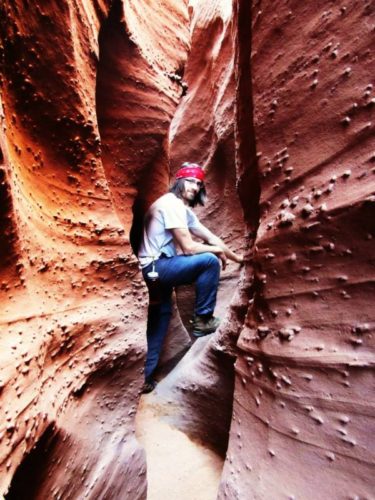
Family-Friendly Canyoneering in Utah’s Slot Canyons
Adventure Is Calling If you’re looking for the perfect family-friendly blend of hiking, scrambling and

You can’t walk on walls! Or can you?

Devleena Dash: A writer by profession, I play with words to make a living, to survive. And then, I turn to mountains and waterfalls to come alive. On most days you’ll find me trekking, hiking, and jumping into all kinds of water bodies I come across. I love adventure sports and try out new ones whenever I can. When I am not trekking, I explore the city on my longboard, hang out with my fam and friends, write poetries, letters, read and cook.
Rappelling is an adventure sport that lets you have the thrill of walking down vertical surfaces. Most of us have seen mountains and hills from atop. We have walked on edges but never dared to explore the edge, lest we fall and injure ourselves.
But the curiosity to explore all sides of a mountain still remains, and that’s where rappelling comes to play.
Rappelling is also a great survival skill. Rappelling helps you in situations like getting down a burning building in times of peril.
Rappelling is an adventure sport wherein an individual uses a harness and other safety equipment to descend a vertical or almost vertical surface. Rappelling is mainly done on mountains and hills and sometimes can be done on vertical walls.
Rappelling comes packed with adrenaline rush and thrill. Every mountain is different, and so is its surface, the obstacles, the view, and height. Every mountain or hill you go rappelling on is a whole new experience altogether.
Being one with nature is known to bring peace and stress relief. That is precisely what rappelling does to you. It also allows you to have a closer look at majestic mountains and beautiful waterfalls that you’ve only seen either from the bottom of the hill or the top of it. Rappelling allows you to be much closer to them.
People of all ages can enjoy rappelling. However, you need to realize that rappelling needs a lot of determination and dedication.
One of my favorite experiences of rappelling was with YMCA. YMCA organizes summer camps for kids and adults (14-18) at YMCA CAMPLAKESIDE in Nilshi. YMCA has a permanent camping site here, and your accommodation, food, transportation is taken care of by them. The stay here is five days long, and one of these days, YMCA takes you on a long night trek in Nilshi.
You spend the night atop the mountain. They provide Camps and sleeping bags. In the morning, you Rappel halfway down on one of the beautiful mountain ranges in Nilshi. They provide all the safety equipment. They also have expert personnel and guides to help you through the process. So if you are a beginner, don’t fret. Once you’ve rappelled down, you start descending the mountain on foot to the permanent campsite.
The whole cost of this camp, including everything mentioned, is INR 5000 ($70)
YMCA also organizes adventure sports, camps, and more throughout for other age groups throughout the year.
Unless you’re a certified guide or experienced climber and mountaineer, do not attempt solo rappelling!
Rappelling is where most mountaineering accidents happen. A single mistake can result in a slip and a fatal fall.
Learn from a teacher. If you are determined to teach yourself, consider these references:
The fundamental elements of rappelling (or abseiling) are:
An enormous amount of technical expertise goes into this, including knot-tying, rope management, belay techniques, anchor building, emergency rescue and outdoor survival skills.
As a member of a guided rappelling group, you will receive instruction in how to safely abseil. Let your guide do their job!
You should know whether to expect dry or wet conditions. Rappelling often takes place around (or inside of) waterfalls, which will definitely soak you!
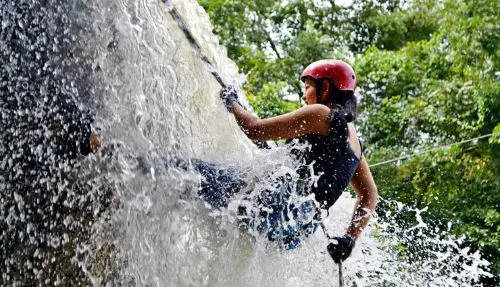

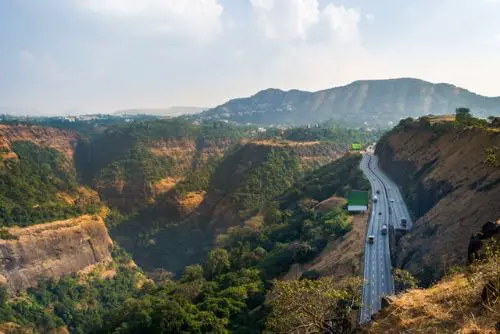
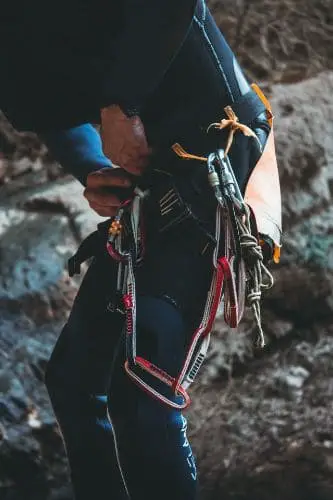
Exploring the Indian Western Ghats is a privilege, no matter what you’re doing!
The Ghats are a UNESCO World Heritage Site and one of the eight hotspots of biological diversity in the world.

Nilshi
Nilshi is filled with several small hill ranges. Most of these hills have spots to rappel. The best way to experience Rappelling in Nilshi is through YMCA. YMCA’s Camp lakeside is situated right near the hill ranges. YMCA takes you for night treks and morning Rappelling through a 5-day camp. These camps take place in April and May (Summer), Winter (months may vary)
Dudhiware Waterfall Rappelling
At the height of 135ft, you can find magnificent views of valleys, waterfalls, and mountain ranges. Dudhiware waterfall near Lonavala is a popular Rappelling spot. Dudhiware waterfall gets its name from the white, gushing waters and is a treat to watch. Imagine Rappelling down it! It is popular in monsoon season, and you can very easily book a slot for Rappelling here.

A beautiful hill station between Mumbai and Pune is home to the majestic Sahyadri Ranges. Easily accessible through flights and cars, it’s a popular vacation spot. There are endless trekking spots and waterfalls here, and most of them are used as Rappelling spots too. The climate here stays cool and breezy all year round, making treks easier to bear and more fun.

Kasara waterfall is located in the Thane district and is a very thrilling spot for rappelling. The drop of the waterfall is 80ft, and throughout the descend, the water is gush over your body. Kasara is a quiet place and with less population. You can have a very peaceful trek here, both before and after the rappel.

Kundalika River rappelling is an ideal Rappelling spot because you can go river rafting in the white waters of the Kundalika River and walk to the nearby waterfall for rappelling. Both these activities can be done on the same day. The strong currents of the river and stronger winds make the rappelling a bit difficult but extremely thrilling and fulfilling.
Though these are a few of the most beautiful Rappelling spots, there are many many other spots. Some of these other spots are Bhivpuri waterfall, Karjat, Matheran, Dodhani Waterfalls, Khopoli, Sadhan valley, and Bhandadara.
These locations let you soak in the beauty of western ghats and let you get lost in the magic and lush of green that these ghats bring.
If you are rappelling with a guide, you should come equipped with a basic knowledge of outdoor navigation, first aid, and trekking skills.
If you are considering rappeling by yourself or without a guide, then this list of required skills becomes much longer!
Now that you know of the dos and don’ts, you must follow a few etiquettes to rappel properly without hurting others.
Rappelling is a sport of balance, flexibility, grip, strength, and promptness. One wrong move can prove injurious or fatal for you. Dangers include getting hit by rocks, colliding with other people near you, slipping, fractures, and more.
The best way to prevent these accidents is to gather all the knowledge you can about the destination. Be well prepared accordingly. Be extremely vigilant. Keep your eye on the rock, your leg, the belay, the rope, all together. You should be alert and looking at every piece of safety equipment properly, and listening to the instructions given by the guides.
Rappelling is a sport of balance, flexibility, grip, strength, and promptness. One wrong move can prove injurious or fatal for you. Dangers include getting hit by rocks, colliding with other people near you, slipping, fractures, and more.
The best way to prevent these accidents is to gather all the knowledge you can about the destination. Be well prepared accordingly. Be extremely vigilant. Keep your eye on the rock, your leg, the belay, the rope, all together. You should be alert and looking at every piece of safety equipment properly, and listening to the instructions given by the guides.
The Western Ghats are a hotspot of biological diversity. Tigers, tahrs, elephants, pit vipers, hornbills, fly catchers, leopards and more!
The bulk of the animal kingdom is found the lower elevations of the hill country, where rainforest predominates. Diversity varies widely between the lush rainforests and the drier montane forests found higher up in the mountains.
Rappelling spots are filled with fantastic flora and fauna if you look closely. If you’re on a mountain, you’ll found beautiful birds, squirrels, mongooses, maybe even some snakes!
If you’re rappelling down a waterfall, you can find little fishes, pretty water flowers, dragonflies, and tiny frogs.
If you’re rappelling on a high cliffside, you might get to enjoy watching a bird fly and dive beneath you!
Rappelling calls for the use of the whole body. You need solid core and leg strength to push yourself off the rock and land back again.
Squats are your best friends if you want to train for rappelling. Do squat jumps 5 sets of 5 reps. Squats 3 sets of 12 rep for core strength.
You can train your legs with 10 minutes of intense running. Run. Take a short break. Repeat.
Swimming/Cycling for an hour is excellent to build cardiovascular strength and core strength. Cardiovascular health helps you take in and use more oxygen, and the core makes rappelling easier.
Dumbell Rows to focus on your back and arm strength that are extremely necessary for rappelling.
Primary Safety Equipment (usually provided by service)
The cost of Rappelling gear is relatively cheap. You can easily get good-quality climbing shoes, helmets, and hiking gear from Amazon or adventure stores like Decathlon, REI.
Usually, people in India choose to go Rappelling through adventure and travel organizers. So, the cost of safety equipment is added to the organizers’ fees. But if you do want to buy safety equipment, you can do so from Decathlon or Add-venture. The safety equipment is a bit on the costlier side. But since quality is vital when participating in a dangerous sport, it’s better to be on the costlier side.
Since mountain tops are not likely to have any shops, it is advisable to carry your food. You can buy food from any supermarket or restaurant for cheap and bring it to the top. Make sure to take mostly dry snacks so that they don’t spill over your camping gear.
Accommodation ranges from hostels to Villas to camps, choose your accommodation according to your budget, time at the top, and one preferably near the Rappelling location. If you want to camp near the site, you can carry your tent.
If you’re flying out from another country, the flight tickets cost according to that country. Living near the trek cuts the cost of traveling altogether. But reaching the base of most locations is easy. You can use an Uber or an Ola and get around for pretty reasonable prices.
Most of the Rappelling locations are free to climb and camp. If you’re trying to Rappel in protected areas, sanctuaries, or national parks, you need to pay a small fee.
One of the best saving tips is participating in the sport through travel organizers and experts.
The hardest part of rappelling is the start! Letting yourself lean backwards off the precipice into thin air and finding your first footing can be a challenge. But once you’ve started, the rest is easy!

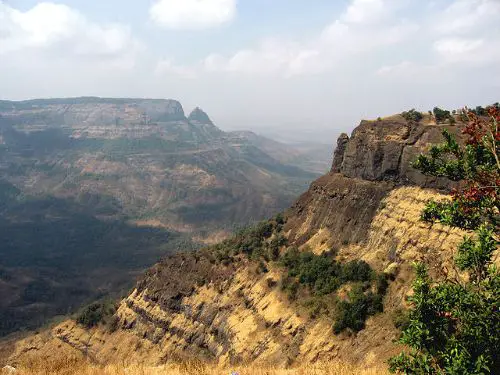
Yes, rappelling is for everyone. From little kids to middle-aged adults, everyone can enjoy rappelling. However, it is a dangerous sport, and hence you must be physically and mentally fit to go Rappelling. One little slip-up can prove fatal.
No, people of all ages can learn and do rappelling given that they are healthy in all aspects.
Make sure you use the washroom before you start ascending. But if you still feel like urinating or pooping, you can do so in a pit. Make a small pit in the mud, do your business there, and fill up the pit with mud and leaves to speed up the composting process. This helps to keep the area clean, makes sure no one steps on your poop and turns your poop and urine into compost before they start spreading diseases.
See Notes on transportation in the Finances & Budget section.
See notes in the “Where and When to Go?” section.
Yes, there are plenty of guides that teach you how to Rappel down mountains and waterfalls. Any Travel organizer you go to has expert personnel to give you ample safety and make your rappelling experience seamless and thrilling.

Adventure Is Calling If you’re looking for the perfect family-friendly blend of hiking, scrambling and

Adventure Is Calling There is just too much beauty in the water. Snorkeling allows you
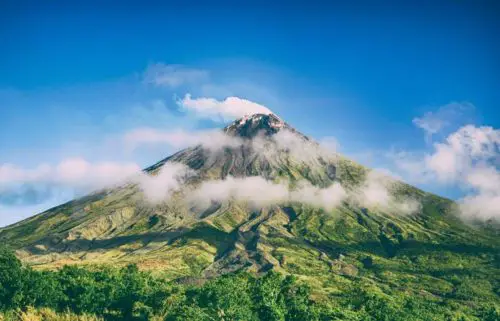
Adventure Is Calling It has been a challenging year; as we transition into new norms
Copyright 2024 – Adventure on the Cheap (SRVS)